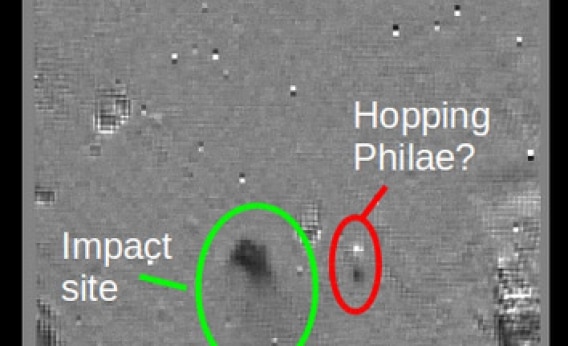Create a free profile to get unlimited access to exclusive videos, sweepstakes, and more!
Philae Spotted Hopping Away in Photo of Comet

A few days ago, the world watched and cheered as the tiny spaceship Philae landed on the surface of a comet. However, it was quickly determined that the anchoring harpoons didn’t fire, and the lander bounced off the comet. It soared a kilometer high before falling agonizingly slowly back down nearly two hours later, only to take a second, shorter hop, ending up in comet incognita.
It took a little while, but images taken by the orbiting Rosetta spacecraft mothership (and assembled into a short video) were released by the European Space Agency showing where Philae impacted the first time. The video shows before-and-after images of where Philae smacked down. At the time, my friend/planetary geologist/Planetary Society blogger Emily Lakdawalla speculated that you could actually see Philae and its shadow in the “after” image, but the data were so noisy I was pretty skeptical.
Turns out, she was right.*
Here is a lovely animated gif showing the two images, with the impact site marked in the first image, and the lander (with shadow) in the second.
Photo by ESA/Rosetta/NAVCAM; pre-processed by Mikel Canania
Amazing! Astrophysicist Eamonn Kerins did this even better: He made a “difference image,” subtracting one from the other to show what’s changed between the two. It really brings out Philae and its shadow:
You can see lots of bright pixels—most likely “hot pixels," overactive spots on the camera detector—with dark ones next to them, a product of how the images were processed. Note how the spot labeled as Philae is blurrier, and the shadow is several pixels below it. That’s pretty convincing to me.
I was initially skeptical because the “plume” stretching below and to the right of the impact site looked the same in both images, and was also mimicked by a similar feature to the upper right; both look like ridge shadows.
In the difference image those go away, so most likely they really are shadows, the lower one coincidentally right on top of where the lander bounced. That’s unfortunate, since it steered me away from what was really happening.
Update, Nov. 17, 2014 at 15:30 UTC: Not long after I posted this, the ESA released a mosaic showing Philae before and after impact, seen moving across the face of the comet by the high-def OSIRIS camera on Rosetta! You can see Philae come in from the lower left, then move off to the right after it bounced. Amazing.
And as a reminder of what you’re seeing: That’s an action shot of a 100 kilogram machine the size of a lounge chair that weighs less than an ounce in the local gravity hitting the surface of a four kilometer-wide dirty snowball almost precisely on target as seen by another spaceship that took 10 years and three planet flybys to achieve its goal of matching the 40,000 kph velocity and entering orbit around a comet … all of which is a first for humanity, ever.
So yeah. Cool.
*At least she was gracious in victory.


























